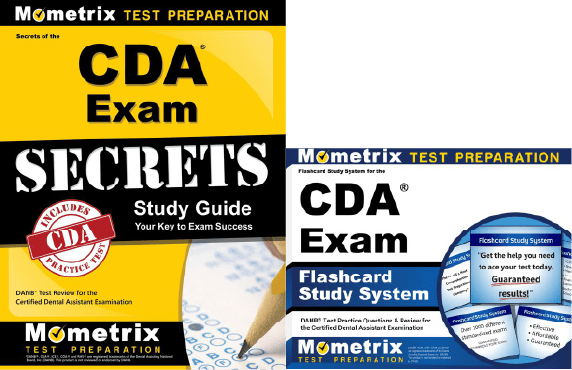If you need help studying for the DANB® CDA® exam or just want some more information about what the test is like, you’ve come to the right place.
Click below to take a free DANB CDA practice test!
What’s on the Exam?
How to Register
Exam Scores
Retaking the Exam
Online DANB CDA Prep Course
What Test-Takers Are Saying
FAQs
Exam Eligibility
Before you can register to take the DANB CDA exam, you’ll have to meet at least ONE of the requirements below:
- You need to have graduated from a CODA-accredited dental assisting/hygiene program and have a current CPR, BLS, or ACLS certification.
- You need at least 3,500 hours of work experience and a current CPR, BLS, or ACLS certification.
- In addition to holding a current CPR, BLS, or ACLS certification, you either need former DANB CDA status or need to have graduated from one of the following:
- A DDS or DMD program
- A dental degree program outside the US
- A post-bachelors program on DANB’s list of accepted programs
If you meet one of these requirements, you’re set to begin the registration process!
What’s on the DANB CDA Exam?
The DANB CDA exam is actually three different exams packed into one! This means that to pass the full CDA exam, you’ll have to take and pass all three of the following exams:
General Chairside Assisting (GC)
95 questions | 75 minutes
- Preliminary exam
- Head, neck, and oral cavity
- Charting conditions of the oral cavity
- Treatment documentation
- Medical conditions that can cause medical complications/emergencies
2. Patient Management and Administration (17%)
- Patient management
- Oral health education
- Administration
3. Chairside Dentistry (50%)
- Four-handed dentistry
- Intraoral procedures
- Armamentarium
4. Dental Materials (16%)
- Impression materials
- Operative materials
- Lab materials
Infection Control (ICE®)
80 questions | 60 minutes
- Infectious diseases
- Reviewing medical histories for transmissible diseases
- Hand hygiene
- PPE
- Minimizing aerosol, droplet, and spatter contact
2. Prevention of Cross-Contamination (34%)
- Cleaning/disinfecting treatment areas and labs
- Prepping and using chemical disinfectants
- Using surface barriers
- Prepping tray setups
- Dental unit water lines
- Cleaning/disinfecting equipment
- Disinfecting impressions and appliances
- Disposing of biohazardous waste
3. Process Instruments and Devices (26%)
- Processing instruments and devices
- Monitoring and maintaining processing equipment
4. Occupational Safety and Administration Protocols (20%)
- Occupational safety regulations, guidelines, and standards,
- Maintaining and documenting programs for infection prevention control and safety
Radiation Health and Safety (RHS®)
75 questions | 60 minutes
- Anatomical landmarks, materials, and conditions observed on images
- Purpose of dental images
- Techniques for acquiring dental images
- Technique modifications
- Error correction
- Purpose of radiographic equipment
- Patient management techniques
- Image viewing and mounting
- Legal requirements for maintaining dental images
2. Radiation Protection (25%)
- Radiation physics
- Radiation biology
- Radiation protection
3. Infection Prevention and Control (25%)
- Standard precautions for equipment and supplies
- Standard precautions for patients and operators
Computer-Adaptive Testing (CAT)
The DANB CDA exam is a computer-adaptive test. Basically, this means that the questions will become harder or easier as you go through the exam, based on how well you’re answering the questions.
For example, say you answered the first question correctly. The first question is of medium difficulty, so the next question will be slightly harder. Then, let’s say you answered the second question incorrectly. The next question would then be a medium question.
How to Register
Once you’ve ensured that you meet all of the eligibility requirements, you can register for the exam!
To get started, you’ll need to submit an application on DANB’s website. The application will ask you for your contact information and any documentation to prove your eligibility (among other things). When you submit the application, you’ll also need to submit the application fee, which is $75.
As soon as you receive authorization to test, you can register to take the exam.
DANB CDA Exam Scores
The three tests within the CDA exam are scored using a scaled scoring method. Here’s how it works:
For every question you answer correctly, you get one point added to your raw score. At the end of each test, your final raw score will be converted to a scaled score. This scaled score will range somewhere between 100 and 900.
The reason your raw score is converted to a scaled score is because everyone who takes the exams is given a slightly different set of questions. Since everyone has a different arrangement of questions, and because some questions are harder than others, converting your raw score to a scaled score ensures a more even playing field.
Retaking the Exam
If you didn’t get a passing score on your first try, that’s okay! You can retake the exam as many times as you need.
Online DANB CDA Prep Course
If you want to be fully prepared, Mometrix offers an online DANB CDA prep course. The course is designed to provide you with any and every resource you might want while studying. The DANB CDA course includes:
The DANB CDA prep course is designed to help any learner get everything they need to prepare for their DANB CDA exam. Click below to check it out!
What Test-Takers Are Saying
Don’t just take our word for it! See what real test-takers are saying about the CDA test:
“There are weird questions like what needle gauge is the smallest and identifying specific details of lidocaine and its numerical contents. You need to know about things like morphology and oral anatomy. You also need to know what candidiasis is, what chlorhexidine is, and much more.”

Obvious-Rush101
“I studied hard and did well in my infection control class, but that test was ROUGH. I really underestimated how many questions would be related to different agencies, and I left feeling pretty defeated.”

Imaginary-Pop7892
“The exam was very difficult: lots of angulation, head anatomy, kVp/mA, and majorly based off of automatic processors or traditional X-rays and less of digital.”

polandspring88
FAQs
How many questions are on the DANB CDA exam?
The full exam contains 250 questions.
What is the time limit for the DANB CDA exam?
The combined time limit for the full exam is 3 hours and 15 minutes.
What is the passing score for the DANB CDA exam?
You’ll need to get a final scaled score of at least 400 on each test (GC, ICE, and RHS) to pass the full exam.
How much does the DANB CDA exam cost?
The testing fee is $450, which doesn’t include the $75 application fee.
DANB®, CDA®, ICE®, COA® and RHS® are registered trademarks of the Dental Assisting National Board, Inc. (DANB). This page is not reviewed or endorsed by DANB.



 DANB CDA Online Course
DANB CDA Online Course DANB CDA Study Guide
DANB CDA Study Guide DANB CDA Flashcards
DANB CDA Flashcards


